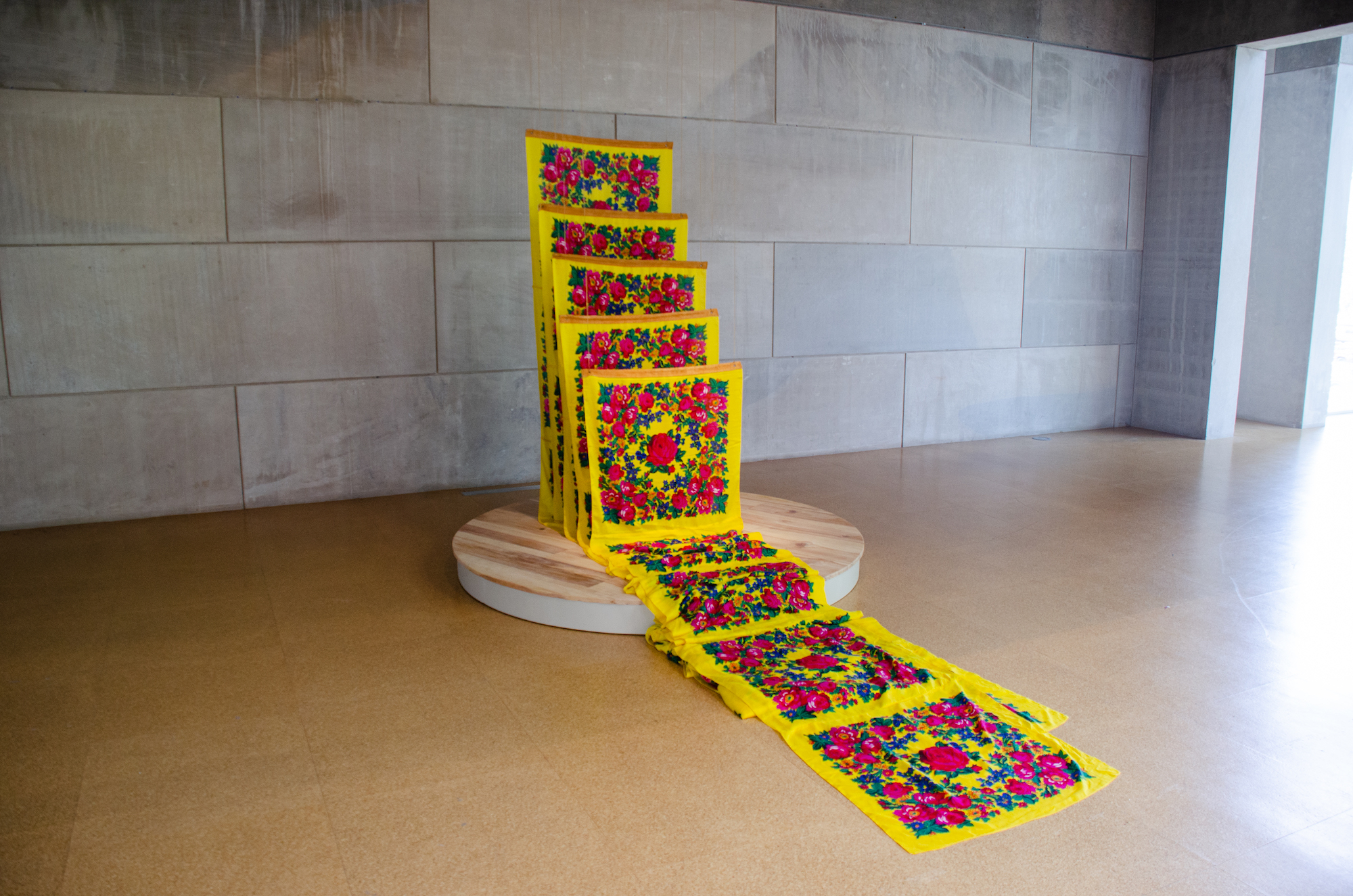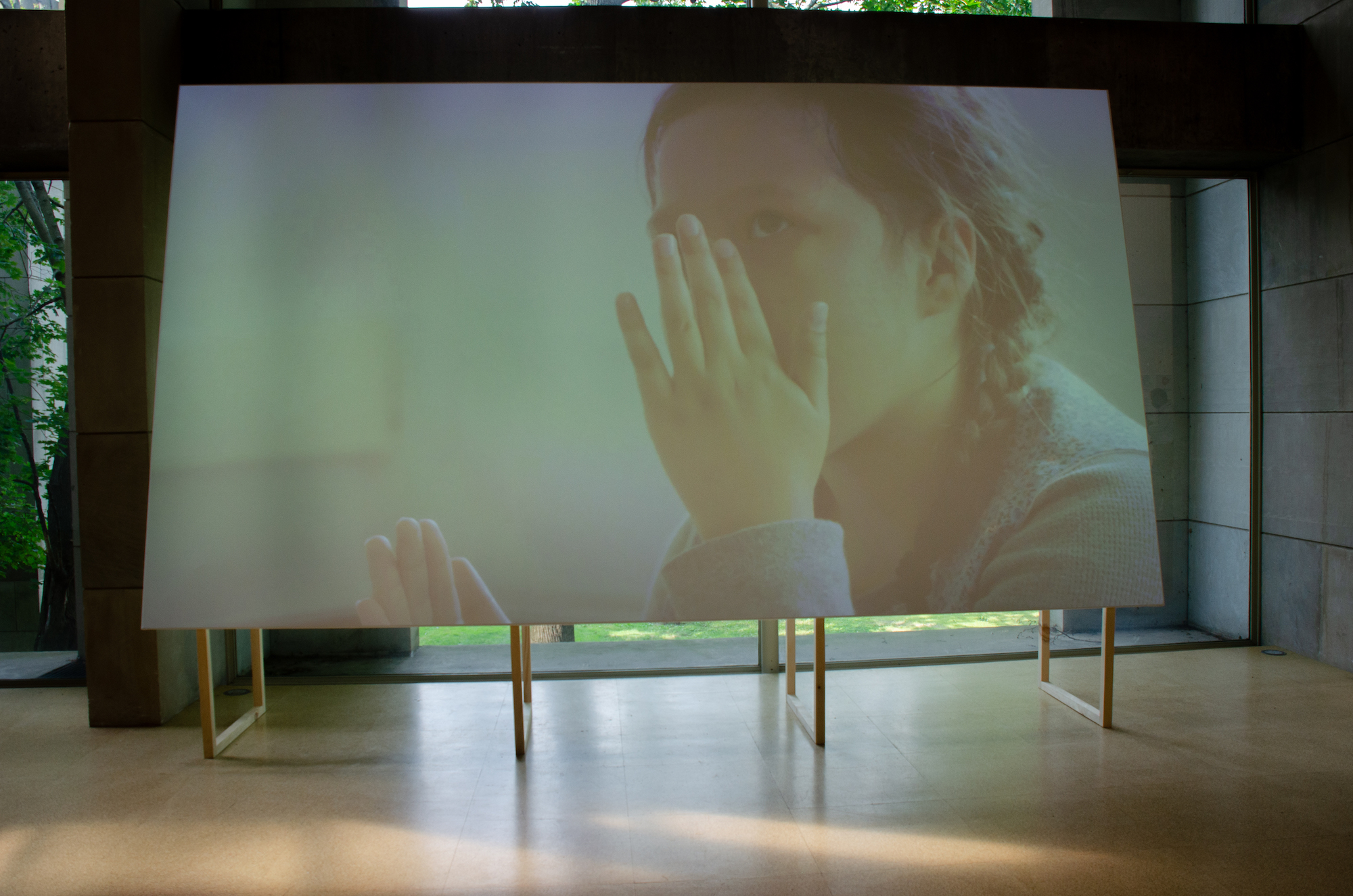
“Is that art?” we asked, observing a ginger root inside a plastic Tupperware container filled with water.
According to artist Jasper Marsalis, it is. Playing with the line between poetry and visual art, the ginger was part of “The Language in Common,” a multimedia exhibition that opened in Zilkha Gallery this Tuesday, Sept. 14. The show features works from a diverse group of artists, including Marsalis, Julien Creuzet, Tanya Lukin Linklater, Alice Notley, and Cecelia Vicuña. The exhibition was developed from an essay written by Steve Lyons and Jason Jones that describes how we can create commonality on the political left; the work advocates for the formation of a space apart from capitalism. Lyons and Jones locate that space within the concept of indigeneity, a theme that resonates throughout the eclectic collection of works on display.
Upon entering the gallery, we were immediately faced with Linklater’s “Breastbone to sunrise,” a flowing yellow structure made primarily from Kohkom floral scarves. The sculpture’s flowers are vibrant and bright pink, and each scarf is placed at a different level. Supported by thin strings attached to the ceiling, the piece sways lightly as people walk by. In doing so, “Breastbone to sunrise” seems to move with the room, the different heights of the piece representing different energy centers for the body. Linklater is a member of the Native Villages of Afognak and Port Lions in the Kodiak archipelago. Her work centers on Indigenous people; their history, lives, and lands; and countering colonial erasure, extraction, and dispossession. The Kohkom scarf is popular within Indigenous communities, specifically grandmothers among First Nations in Canada. The word Kohkom means grandmother in Cree, and the scarf is seen as a resilient symbol, wrapping Indigenous people in generations of love and support.
The show’s standout piece was Vicuña’s “Quipu Viscera,” which occupied the main volume of the gallery with giant strings of knotted wool, called quipu, hanging from the ceiling. Quipus are ancient Inca devices used to communicate and record information through a specific series of knots. Vicuña’s installation presents quipus of many different pigments, including pinks, purples, and neutrals that culminate in a forest of color that the viewer is invited to walk through. Navigating these woven strands gives the impression of entering a sea anemone, heightening your smallness as a human being. You feel connected to ancient history and, even though nothing is spoken, you share the common language of experiencing the piece with fellow visitors. Vicuña will come to Wesleyan for an artist talk and performance on Wednesday, Oct. 13 at 6 p.m.
Next to “Quipu Viscera” is a wall filled with small, individually framed sketches on Hahnemühle paper by American poet Alice Notley. While at first glance the works appear to be drawn with colored pencils, with words scribbled hastily in the artist’s handwriting, the pictures were actually created on an iPad with an Apple Pencil. This nuanced digital format is a change for Notley, who was originally active in the New York poetry scene in the 1960s and ’70s. Notley produced her sketches after her child showed her how to use an iPad, inspiring her to immediately start sketching. Each drawing seems to be a snapshot of Notley’s mind at any given moment. One reads “What if the blame just collapsed?” in blocky, bright red letters. Another sketch features words written all over a face mask, with the words themselves appearing to form the mask. This is only Notley’s second official showcase of her art, and the first time she has ever displayed these iPad drawings. There are 45 in total, and each one is worth spending time with.

The exhibition’s sole video piece, entitled “the treaty is in the body,” takes up an oversized screen that leans towards the viewer, drawing them in. The video, Linklater’s second piece in the show, features dancers, knowledge keepers, and more from families from the Omaskeko Cree nation in North Bay, Ontario discussing the meaning of a treaty. Throughout the video, adults speak with each other, while children jump around and braid each other’s hair. The video, importantly, is soundless, reserving the depicted discussion for members of the tribe, and keeping it from outsiders (the viewers) who are not meant to hear it. This element of the video echoes and subverts the history of Indigenous peoples in the Americas, who were forced to sign treaties written by invading Europeans, in languages that Indigenous groups did not speak. There was no “language in common” between them and colonizers, resulting in frequent misunderstandings. Linklater excludes the viewer while still requiring them to engage with video. Once you’ve started watching, you won’t want to walk away.
Turning away from Linklater’s imposing screen, you shouldn’t miss two bright silver rocks, a disembodied leather suit, and, of course, the floating piece of ginger root, all part of Marsalis’ contribution to the show. During Associate Director of Visual Art Benjamin Chaffee’s talk, he spoke of how the rocks were extracted from Wesleyan’s campus, leaving two voids on the grounds. The patch of dirt showing one rock’s absence was the central image for the exhibition’s poster. After the exhibition, they will be returned to their proper places. The disembodied leather cowboy-esque suit stands in the middle of the room, seemingly misplaced. Its position allows the viewer to circle the entire suit. Once more, the theme of language emerges, inspiring questions about the way that the clothing we wear impacts our identities and the way in which we are perceived. You can conjure countless tales about this suit’s life, but there is no way to know its truth; the viewer must create their own language to describe it. Finally, Marsalis’ ginger was, quite simply, a spectacle to behold. Staring down at the container, we once again questioned what art is, and how it intersects with memory, reality, and poetry. The ginger has toothpicks in it and will grow over the course of the exhibition.
Not to be forgotten, three Julien Creuzet pieces take up the entirety of Zilkha’s north gallery. One is a two-channel audio piece, and one is composed of black steel plating that is placed on the floor. Again, we questioned whether we could walk on top of the pieces or if we had to avoid stepping on them. We saw gallery visitors do both, raising the question of where we belong, and where it is acceptable for our feet to walk. Creuzet, as it turns out, actively invites viewers to walk on top of the work, once more creating a common language through the shared experience of stepping on art. Creuzet is a French-Caribbean visual artist and poet, and his works often have unclear boundaries. Another sculpture, created from metal, plastic, and fabric, hangs on the wall. It also features bright colors, as well as textured, interconnected tubes. The piece is entitled “Meander, mix, Wawette, moving world, wind sweeping, my ocean angel, blue phantom buoy, drink, piece of atom, tub, when I breathe in the flavors of autumn, clouds. A moment between two gestures, a thought nap under the celestial beauty. Evening imaginary sharing, our bodies submerged. Sweet beatitude for our worlds, mouthed, speckled under the orange sky in fire, sweet kisses,” which speaks for itself.
“Language in Common” is, at its heart, about creating community. The limits of the exhibit are porous, and the questions each piece poses make the viewer reflect in a potentially new way. How does this language hold people together? How do politics unite or splinter our common language? Is a common language even possible? After leaving the show, we had more questions than answers, and one can’t help but wonder the ultimate question—what is the language in common?
This exhibition is ongoing, and there will be multiple opportunities to connect with the featured artists throughout the fall. Cecelia Vicuña will return for an in-person performance and artist talk on Oct. 13 at 6 p.m. Along with that, two online events will also take place. On Oct. 6 at 4:30 p.m, Tanya Lukin Linklater will give an online poetry reading from her first book “Slow Scrape.” Julien Creuzet will also give an online artist talk on Nov. 15 at 12 p.m.
Sophie Griffin can be reached at sgriffin@wesleyan.edu.
Maya Gray can be reached at mgray@wesleyan.edu.



Leave a Reply